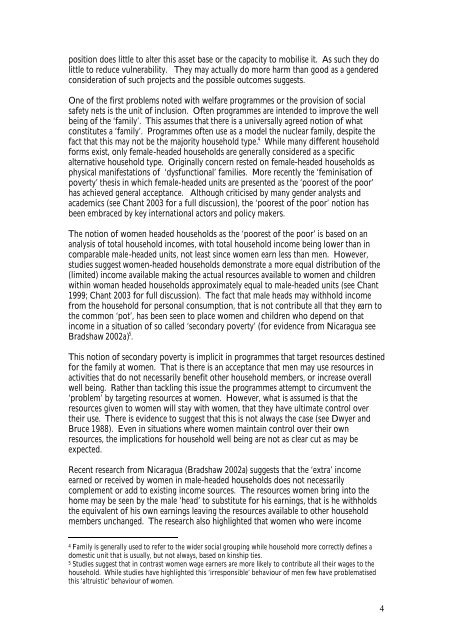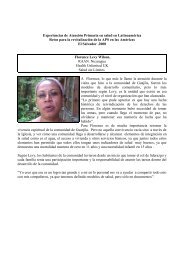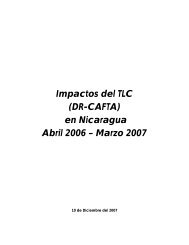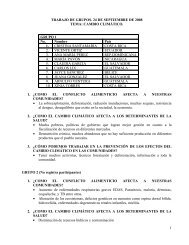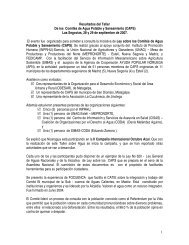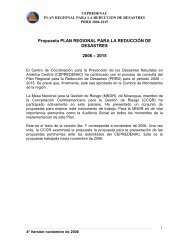A Gendered Analysis of the Social Protection Network in ... - CISAS
A Gendered Analysis of the Social Protection Network in ... - CISAS
A Gendered Analysis of the Social Protection Network in ... - CISAS
Create successful ePaper yourself
Turn your PDF publications into a flip-book with our unique Google optimized e-Paper software.
position does little to alter this asset base or <strong>the</strong> capacity to mobilise it. As such <strong>the</strong>y do<br />
little to reduce vulnerability. They may actually do more harm than good as a gendered<br />
consideration <strong>of</strong> such projects and <strong>the</strong> possible outcomes suggests.<br />
One <strong>of</strong> <strong>the</strong> first problems noted with welfare programmes or <strong>the</strong> provision <strong>of</strong> social<br />
safety nets is <strong>the</strong> unit <strong>of</strong> <strong>in</strong>clusion. Often programmes are <strong>in</strong>tended to improve <strong>the</strong> well<br />
be<strong>in</strong>g <strong>of</strong> <strong>the</strong> ‘family’. This assumes that <strong>the</strong>re is a universally agreed notion <strong>of</strong> what<br />
constitutes a ‘family’. Programmes <strong>of</strong>ten use as a model <strong>the</strong> nuclear family, despite <strong>the</strong><br />
fact that this may not be <strong>the</strong> majority household type. 4 While many different household<br />
forms exist, only female-headed households are generally considered as a specific<br />
alternative household type. Orig<strong>in</strong>ally concern rested on female-headed households as<br />
physical manifestations <strong>of</strong> ‘dysfunctional’ families. More recently <strong>the</strong> ‘fem<strong>in</strong>isation <strong>of</strong><br />
poverty’ <strong>the</strong>sis <strong>in</strong> which female-headed units are presented as <strong>the</strong> ‘poorest <strong>of</strong> <strong>the</strong> poor’<br />
has achieved general acceptance. Although criticised by many gender analysts and<br />
academics (see Chant 2003 for a full discussion), <strong>the</strong> ‘poorest <strong>of</strong> <strong>the</strong> poor’ notion has<br />
been embraced by key <strong>in</strong>ternational actors and policy makers.<br />
The notion <strong>of</strong> women headed households as <strong>the</strong> ‘poorest <strong>of</strong> <strong>the</strong> poor’ is based on an<br />
analysis <strong>of</strong> total household <strong>in</strong>comes, with total household <strong>in</strong>come be<strong>in</strong>g lower than <strong>in</strong><br />
comparable male-headed units, not least s<strong>in</strong>ce women earn less than men. However,<br />
studies suggest women-headed households demonstrate a more equal distribution <strong>of</strong> <strong>the</strong><br />
(limited) <strong>in</strong>come available mak<strong>in</strong>g <strong>the</strong> actual resources available to women and children<br />
with<strong>in</strong> woman headed households approximately equal to male-headed units (see Chant<br />
1999; Chant 2003 for full discussion). The fact that male heads may withhold <strong>in</strong>come<br />
from <strong>the</strong> household for personal consumption, that is not contribute all that <strong>the</strong>y earn to<br />
<strong>the</strong> common ‘pot’, has been seen to place women and children who depend on that<br />
<strong>in</strong>come <strong>in</strong> a situation <strong>of</strong> so called ‘secondary poverty’ (for evidence from Nicaragua see<br />
Bradshaw 2002a) 5 .<br />
This notion <strong>of</strong> secondary poverty is implicit <strong>in</strong> programmes that target resources dest<strong>in</strong>ed<br />
for <strong>the</strong> family at women. That is <strong>the</strong>re is an acceptance that men may use resources <strong>in</strong><br />
activities that do not necessarily benefit o<strong>the</strong>r household members, or <strong>in</strong>crease overall<br />
well be<strong>in</strong>g. Ra<strong>the</strong>r than tackl<strong>in</strong>g this issue <strong>the</strong> programmes attempt to circumvent <strong>the</strong><br />
‘problem’ by target<strong>in</strong>g resources at women. However, what is assumed is that <strong>the</strong><br />
resources given to women will stay with women, that <strong>the</strong>y have ultimate control over<br />
<strong>the</strong>ir use. There is evidence to suggest that this is not always <strong>the</strong> case (see Dwyer and<br />
Bruce 1988). Even <strong>in</strong> situations where women ma<strong>in</strong>ta<strong>in</strong> control over <strong>the</strong>ir own<br />
resources, <strong>the</strong> implications for household well be<strong>in</strong>g are not as clear cut as may be<br />
expected.<br />
Recent research from Nicaragua (Bradshaw 2002a) suggests that <strong>the</strong> ‘extra’ <strong>in</strong>come<br />
earned or received by women <strong>in</strong> male-headed households does not necessarily<br />
complement or add to exist<strong>in</strong>g <strong>in</strong>come sources. The resources women br<strong>in</strong>g <strong>in</strong>to <strong>the</strong><br />
home may be seen by <strong>the</strong> male ‘head’ to substitute for his earn<strong>in</strong>gs, that is he withholds<br />
<strong>the</strong> equivalent <strong>of</strong> his own earn<strong>in</strong>gs leav<strong>in</strong>g <strong>the</strong> resources available to o<strong>the</strong>r household<br />
members unchanged. The research also highlighted that women who were <strong>in</strong>come<br />
4 Family is generally used to refer to <strong>the</strong> wider social group<strong>in</strong>g while household more correctly def<strong>in</strong>es a<br />
domestic unit that is usually, but not always, based on k<strong>in</strong>ship ties.<br />
5 Studies suggest that <strong>in</strong> contrast women wage earners are more likely to contribute all <strong>the</strong>ir wages to <strong>the</strong><br />
household. While studies have highlighted this ‘irresponsible’ behaviour <strong>of</strong> men few have problematised<br />
this ‘altruistic’ behaviour <strong>of</strong> women.<br />
4


